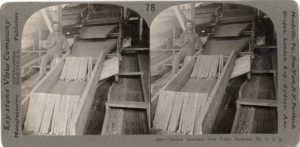Editor’s note: This is a guest post by Allison Spencer, the Society’s Summer 2019 intern and a candidate for a Master’s in Library and Information Science at Drexel University. Allison scanned and cataloged a large collection of the Society’s mining-related photos and other images. Here she writes about an image that she found particularly interesting.
 Even as I was choosing this stereograph for a blog post, I found it odd that this was one of the most interesting images to me. The image on this stereograph is just a worker, possibly a miner, sitting next to a tandem automatic slate picker. Looking at the image, it seems so mundane that you would never guess that something so interesting is written on the back of the stereograph. Most times, when I came across a stereograph during my scanning project, there might have been a few handwritten notes on the back, usually identifying a date or a photographer. However, when I came across the one titled “Tandem Automatic Slate Picker,” I was surprised to find three paragraphs printed on the back.
Even as I was choosing this stereograph for a blog post, I found it odd that this was one of the most interesting images to me. The image on this stereograph is just a worker, possibly a miner, sitting next to a tandem automatic slate picker. Looking at the image, it seems so mundane that you would never guess that something so interesting is written on the back of the stereograph. Most times, when I came across a stereograph during my scanning project, there might have been a few handwritten notes on the back, usually identifying a date or a photographer. However, when I came across the one titled “Tandem Automatic Slate Picker,” I was surprised to find three paragraphs printed on the back.
The first paragraph describes the purpose of a tandem automatic slate picker. For those who may not know what the process entails, when the coal is first mined, the usable coal is mixed in with other minerals, called slate. Before any type of machinery was invented, it was the job of the “breaker boys” to sit, hunched over, to sort the coal from the other materials. Typically, these boys were between the ages of nine and fifteen, and they would work all day long. The tandem automatic slate picker replaced the work of the breaker boys. After explaining the use of the slate picker, whoever wrote this went off on what I can only describe as a rant.
The second paragraph begins by discussing child labor laws, but instead of supporting them, the writer is against these laws. Whoever wrote this text devoted the entire paragraph to the idea that it is horrible that children no longer have the chance to work all day and, by extension, figure out if this is what they want to do with their lives. I was shocked to read this and found it unbelievable that someone put these thoughts into writing – that all children should have the chance to make the most of their lives by working in the coal mines.
After the rant about the injustices of child labor laws, the writer returned to the tandem automatic slate picker. After seeing this stereograph, I began to research child labor laws at the time. I found an article written in 1911 by Owen R. Lovejoy, which had some interesting insights into the Pennsylvania child labor laws of the early 1900s. Technically speaking, children under the age of fourteen were forbidden from working in the coal breakers, and children under the age of sixteen were forbidden from working in the coal mines. However, it was up to the discretion of the parent or employer to determine the age of the child. So, instead of being required to provide documentation for the child’s age, the parent or employer only needed to lie about the child’s age to get around these prohibitions (Lovejoy, 1911, p. 134). According to the article, in 1909, two years prior to its publication, an amendment was passed in Pennsylvania that proof of age was required to employ a child, instead of allowing parents to verbally verify that the child was old enough to work (Lovejoy, 1911, p. 135).
Lovejoy, O. (1911). The Coal Mines of Pennsylvania. The Annals of the American Academy of Political and Social Science, 38, 133-138. Retrieved from http://www.jstor.org/stable/1011890.
To see more of the mining images in the LCHS collection, visit https://luzernehistory.omeka.net/ to see the online exhibit that Allison curated.

Allison, good spotting ! Loved your insightful reading, and share your horror at the notions people held.
Thanks, Garth! We are so pleased that you read the post and appreciated Allison’s insights!